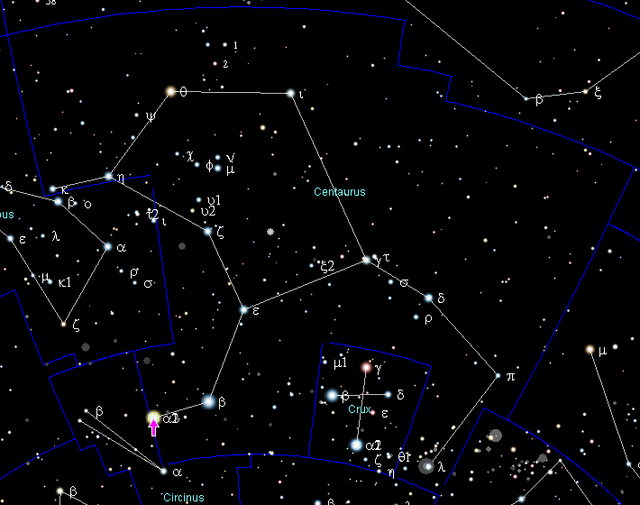Alpha Centauri
triple star system in the constellation Centaurus, where one of the three stars, Proxima Centauri, being the closest star to the Earth From Wikipedia, the free encyclopedia
Remove ads
Alpha Centauri (also known as Rigil Kentaurus) is the brightest star in the southern Centaurus constellation.[2] It is the fourth brightest star in the night sky, with a magnitude of -0.01. It is visible in the Southern Hemisphere, and is too far south for most of the Northern Hemisphere to see.


The Apparent Orbit (thin ellipse) is the shape of the orbit as seen by the observer on Earth. The True Orbit is the shape of the orbit viewed perpendicular to the plane of the orbital motion. According to the radial velocity vs. time,[1] the orbit is divided here into 80 points, and each step refers to a timestep of almost a year.
Alpha Centauri is a binary star system of two stars A & B. The distance between them is quite close. To the naked eye, the stars are too close for the eye to be able to see them as separate. Their orbit is about the distance of the giant planets from our Sun.
There is a third star, Proxima Centauri (or Alpha Centauri C). This is usually considered separately, but in fact it is also gravitationally connected to the other two. It is actually slightly closer to us, with a very much larger orbit around A and B.
Remove ads
System

Viewed as a triple star system, Alpha Centauri is the closest to our own, being 4.2-4.4 light years (ly) away. It consists of two main stars, Alpha Centauri A and Alpha Centauri B (which form a binary star together) at a distance of 4.36 ly, and a dimmer red dwarf named Proxima Centauri at a distance of 4.22 ly. Both of the two main stars are rather similar to the Sun. The larger star, Alpha Centauri A, is the most similar to the Sun, but a little larger and brighter.
- The next closest star is Barnard's Star.
Remove ads
Diameter and radius
Alpha Centauri is 1,702,240 km in diameter and 851,120 km in radius.
Future exploration
Alpha Centauri is going to be the first target for a crewed or a robotic spacecraft mission. Using current spacecraft technology, reaching Alpha Centauri would take thousands of years. However, with nuclear propulsion and solar sails, it could take several decades.
The existence of Proxima Centauri b, announced by the European Southern Observatory, could be a target for the first interstellar missions.
In 2069, NASA plans to send a space probe to Alpha Centauri, the closest star system to the Sun. The mission is supposed to launch on the 100th anniversary of Apollo 11.[3][4]
Related pages
Notes
Wikiwand - on
Seamless Wikipedia browsing. On steroids.
Remove ads
